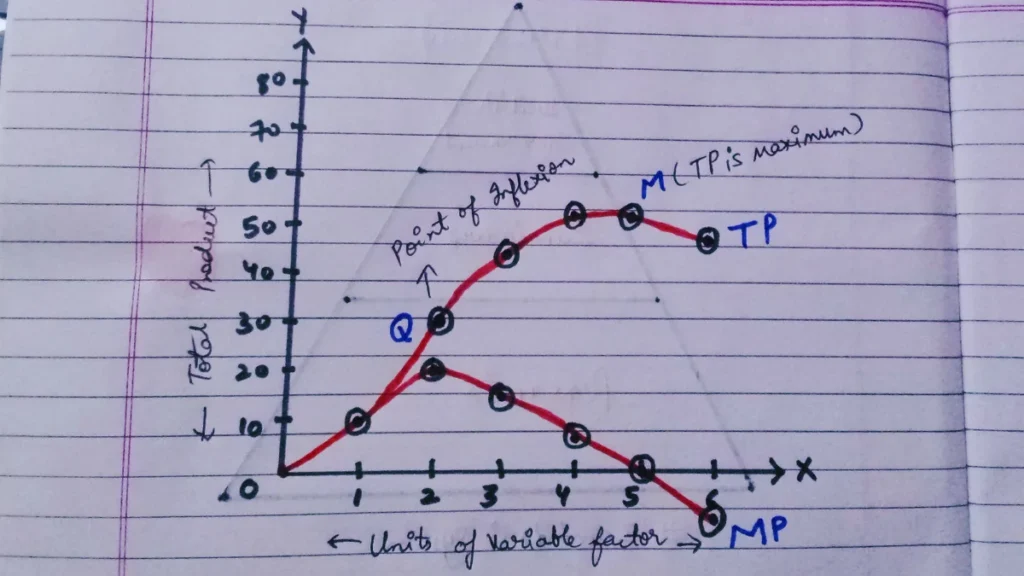Production refers to the transformation of inputs into output. Here are the notes of the chapter ‘Production Function’. Here are production function class 11 notes.
Topics Discussed
Production Function

The production function is an expression of the technological relation between physical inputs and output of a good.
Difference between Short Run and Long Run
| Basis | Short Run | Long Run |
| Meaning | Short run refers to a period in which output can be changed by changing only variable factors. | The long run refers to a period in which output can be changed by changing all factors of production. |
| Classification | Factors are classified as variable and fixed factors in the short run. | All factors are variable in the long run. |
| Price Determination | In the short run, demand is more active in price determination as supply cannot be increased immediately with an increase in demand. | In the long run, both demand and supply play an equal role in price determination as both can be increased. |
Difference between Variable factors and Fixed factors
| Basis | Variable Factors | Fixed Factors |
| Meaning | Variable factors refer to those factors which can be changed in the short run. | Fixed factors refer to those factors which can not be changed in the short run. |
| Relation with Output | They vary directly with the output. | They do not vary directly with output. |
| Example | Raw material, casual labor, power, fuel, etc. | Building, plant and machinery, permanent staff, etc. |
Types of Production Functions
Short Run Production Function
Short-run production function refers to a situation when output is increased by changing only one input while keeping other inputs unchanged.
Long Run Production Function
Long-run production function refers to a situation when output is increased by increasing all the inputs simultaneously and in the same proportion.
Concept of Product
Product refers to the volume of goods produced by a firm during a specified period.
- Total Product (TP): It refers to the total quantity of goods produced by a firm during a given period.
- Average Product (AP): It refers to the output per unit of variable inputs.
- Marginal Product (MP): It refers to the additional to total output where one more unit of variable factor is employed.
Elasticity of Demand Class 11 Notes
Law of Variable Proportion
The law of variable proportion states that as we increase the quantity of only one input keeping other inputs fixed, the total product(TP) initially increases at an increasing rate, then at a decreasing rate, and finally at a negative rate.
| Fixed Factor | Variable Factor | TP | MP | Remarks |
| 1 | 1 | 10 | 10 | Increasing Return |
| 1 | 2 | 30 | 20 | Increasing Return |
| 1 | 3 | 45 | 15 | Diminishing Return |
| 1 | 4 | 52 | 7 | Diminishing Return |
| 1 | 5 | 52 | 0 | Diminishing Return |
| 1 | 6 | 48 | -4 | Negative Return |

Assumptions of the Law of Variable Proportion
- LVP always operates in the short run.
- This law applies to the field of production only.
- The effect of change in output due to change in variable factors can be easily determined.
Phases of LVP
There are 3 phases of LVP:
1) Increasing Returns to Factor
In the first phase, every additional variable factor adds more and more to the total output, which means TP increases at an increasing rate and MP also rises.
2) Diminishing Returns to Factor
In the second phase, an additional variable factor adds less amount of output. It means TP increases at a diminishing rate and MP starts falling.
3) Negative Returns to Factor
It is the third phase of LVP in which the employment of an additional variable factor causes TP to decline and MP becomes negative therefore, this phase is known as the negative return.
Reasons for LVP Phases
Reasons for Increasing Return to Factor
- Better Utilization of Fixed Factor: In the first phase, the supply of the fixed factor is too large, whereas variable factors are too low. So, with an additional variable factor, the fixed factor is better utilized, and output increases at an increasing rate.
- Increased Efficiency of Variable Factor: When variable factors are increased and combined with fixed factors, there is great cooperation and a high degree of specialization. As a result, variable factors work efficiently.
Reasons for Diminishing Return to a Factor
- The optimum combination of factors: After making the optimum use, MP begins to diminish.
- Imperfect Substitutes: Diminishing returns occur because fixed and variable factors become imperfect substitutes for each other. There is a limit for which these can be substituted with one another. After that limit, they become imperfect substitutes which leads to diminishing returns.
Negative Returns to Factors
- Limitation of Fixed Factor: The negative return applies because some factors of production are fixed and cannot be increased in the short run.
- Poor Coordination between Variable and Fixed Factors: When Variable factors become too excessive about fixed factors, they then become obstructed with each other which leads to poor coordination.
Relationship between TP and MP
- As long as TP increases at an increasing rate, MP also increases.
- When TP increases at a diminishing rate, MP decreases.
- When TP reaches its minimum point, MP becomes zero.
- When TP starts decreasing, MP becomes negative.
Relationship between AP and MP
- As long as MP is more than AP, AP rises.
- When MP is equal to AP, AP is at its maximum.
- When MP is less than AP, AP falls.
- Both AP and MP fall but MP becomes negative whereas AP remains positive.
This was all about Production Function Class 11 Notes. If you have any doubts, you can either join our telegram channel or ask those doubts in the comments section.
[…] Production Function Class 11 Notes […]
[…] Production Function Class 11 Notes Microeconomics […]
[…] Production Function Class 11 Notes Economics […]